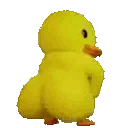

Just a reminder, these corporations and not making razor thin margins. They can afford to pay better wages.


Just a reminder, these corporations and not making razor thin margins. They can afford to pay better wages.


“Our technologies permit us to manipulate time and space. They leave distance annihilated, cause things to grow, and improve productivity”
I - too - can walk, garden, and drink coffee.


You did it! 🎉


Print what? I skimmed the article and I’m confused. Can you print an 3D Eiffel tower on a piece of paper? Or is it more like you’re printing things with a small emboss/raised edge? I didn’t even realize that was something people wanted to do. Maybe for custom tiling?


Yup. Humans need housing, food, health, community, and a little comfort. How is the richest nation in the world failing to provide that for every person and yet simultaneously using so many resources to hurt a minority of its people (trans people). It’s maddening. And every Republican seems happy with this status quo.


I’ll put the nation’s debt on my credit card. 


This is the dumbest timeline.


I fucking hate it here but I can’t get a job abroad that’ll sponsor me. This is my home. But it’s a dump rolling towards a cliff. Get me out.





Where are the numbers


TBF if you want, you can have a bastion server which is solely whitelisted by IP to stream your content from your local server. It’s obviously a pivot point for hackers, but it’s the level of effort that 99% of hackers would ignore unless they really wanted to target you. And if you’re that high value of a target, you probably shouldn’t be opening any ports on your network, which brings us back to your original solution.
I, too, don’t expose things to the public because I cannot afford the more safe/obfuscated solutions. But I do think there are reasonable measures that can be taken to expose your content to a wider audience if you wanted.


Nice ( ͡° ͜ʖ ͡°)


Holy shit the article is far less tame than the title. They provided several ways to run commands as root and they can be generated as an over-the-air HTTP call. As per the article, if you buy the Jooki domain, it’s very likely you can control every single Jooki on the market. You can make the speaker do whatever you’d like. Pretty scary stuff. One has to wonder what nerds can do with that kind of tech: turn speakers into a low quality mic? Use them as bots for a DDoS attack? Just start blasting heavy metal music? Or just brick every device?
It’s pretty wild what the devs have done here. I can excuse executing commands as root from a file on the SD card. It’s not exactly safe or smart but it’s also not the most dangerous thing to assume only people with access to the device would do that. Hardly a worry for most parents as long as you’re not especially reckless. But to allow OTA root level commands to be run? That’s a horrible design. At least setup a user that can only execute a few pre-designed scripts. Don’t just give them carte blanch to run havoc on your hardware.
Just another reminder that every wifi enabled device is likely a ticking timebomb. Especially low quality devices meant for kids. Baby monitors, speakers, etc. have a history of being built cheaply and poorly. That’s why I bought non-wifi baby monitors for my family.


In a world where space is usually the cheapest and most available hardware on a PC, I tend to agree. That being said, it’s the kind of solution that comes from engineers who put the onus on the hardware to make up for their shitty software. Engineers like me.
deleted by creator


As someone who has been watching her Tiktoks for many years, it makes me happy.


deleted by creator


deleted by creator


I paid for the lifetime membership ~6 years ago so I’m going to stick with it. Plus I just use it for my own home. It’s not like I’m serving a bunch of other clients. But I’ll switch to Jellyfin if the lifetime membership ever gets taken away.
My lazy hack for debugging any program is running the main executable from the command line. That usually streams the logs into the terminal and helps me debug from there.